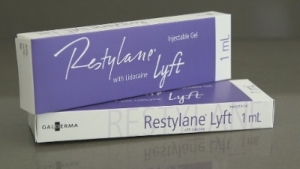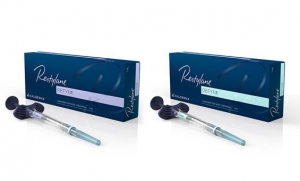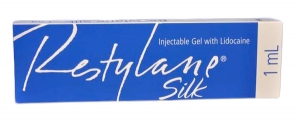


The Restylane family of products includes Restylane®, Restylane-L®, Restylane® Lyft with Lidocaine, Restylane® Silk, Restylane® Refyne, and Restylane® Defyne.
APPROVED USES
Restylane® and Restylane-L® are for mid-to-deep injection into the facial tissue for the correction of moderate to severe facial wrinkles and folds, such as nasolabial folds. Restylane® and Restylane-L® are also indicated for injection into the lips in patients over the age of 21.
Restylane® Lyft with Lidocaine is for deep implantation into the facial tissue for the correction of moderate to severe facial wrinkles and folds, such as nasolabial folds and for cheek augmentation and for the correction of age-related midface contour deficiencies in patients over the age of 21. Restylane Lyft was previously known as Perlane.
Restylane® Silk is for lip augmentation and for correction of perioral wrinkles in patients over the age of 21.
Restylane® Refyne is for mid-to-deep injection into the facial tissue for the correction of moderate to severe facial wrinkles and folds, such as nasolabial folds, in patients over the age of 21.
Restylane® Defyne is for mid-to-deep injection into the facial tissue for the correction of moderate to severe deep facial wrinkles and folds, such as nasolabial folds, in patients over the age of 21.
Both Defyne and Refyne are re-branded products which are known in Europe as fillers of the Emervel family.
Are there any reasons why I should not use products within the Restylane® family? (Contraindications)
To ensure a safe procedure, your doctor will talk to you about your medical history to determine if you are an appropriate candidate for treatment. You should not use products within the Restylane family if:
• You have severe allergies with a history of severe reactions (anaphylaxis)
• You are allergic to lidocaine or to any of the gram-positive bacterial proteins used to make hyaluronic acid
• You are prone to bleeding or have been diagnosed with a bleeding disorder
Are there other precautions that I should discuss with my doctor?
• Tell your doctor if you are breastfeeding, pregnant, or trying to become pregnant. The safety of these products for use during pregnancy, or in women who are breastfeeding, has not been studied
• Restylane, Restylane-L, Restylane® Lyft with Lidocaine, Restylane Refyne and Restylane Defyne are intended to treat facial wrinkles and folds, such as nasolabial folds. Restylane and Restylane-L are also intended for lip enhancement. Treatments in other areas of the face have not been evaluated in clinical studies.
• The safety and effectiveness of Restylane® Silk for areas other than the lips and perioral area have not been evaluated in clinical studies
• Tell your doctor if you have any history of scarring, particularly thick and stiff scars, or any pigmentation (skin color) disorders. These side effects can occur with hyaluronic acid fillers in general.
• Tell your doctor if you are planning other laser treatments or a chemical peel, as there is a possible risk of inflammation at the treatment site if these procedures are performed after treatment
• Patients who experience skin injury near the site of injection with these products may be at a higher risk for side effects
• Tell your doctor if you are on any medications to decrease your body’s immune response (immunosuppressive therapy). Using these medications may increase your risk of bruising or bleeding at the gel injection site.
• Tell your doctor if you are using any “blood thinners” such as aspirin, warfarin, or any other medications that affect bleeding. Using these medications may increase your risk of bruising or bleeding at the gel injection site.
• The use of these products on gel injection sites with skin sores, pimples, rashes, hives, cysts, or infections should be postponed until healing is complete. Use of product in these areas could delay healing or make your skin problems worse.
What are the possible side effects?
The most commonly observed side effects are swelling, redness, pain, bruising, headache, tenderness, lump formation, and itching at the injection site. These are typically mild in severity and typically resolve in less than 7 days in nasolabial folds and less than 14 days in lips. Serious but rare side effects include delayed onset infections, recurrence of herpetic eruptions, and superficial necrosis at the injection site.
One of the risks with using this product is unintentional injection into a blood vessel. The chances of this happening are very small, but if it does happen, the complications can be serious, and may be permanent. These complications, which have been reported for facial injections, can include vision abnormalities, blindness, stroke, temporary scabs, or permanent scarring of the skin.
